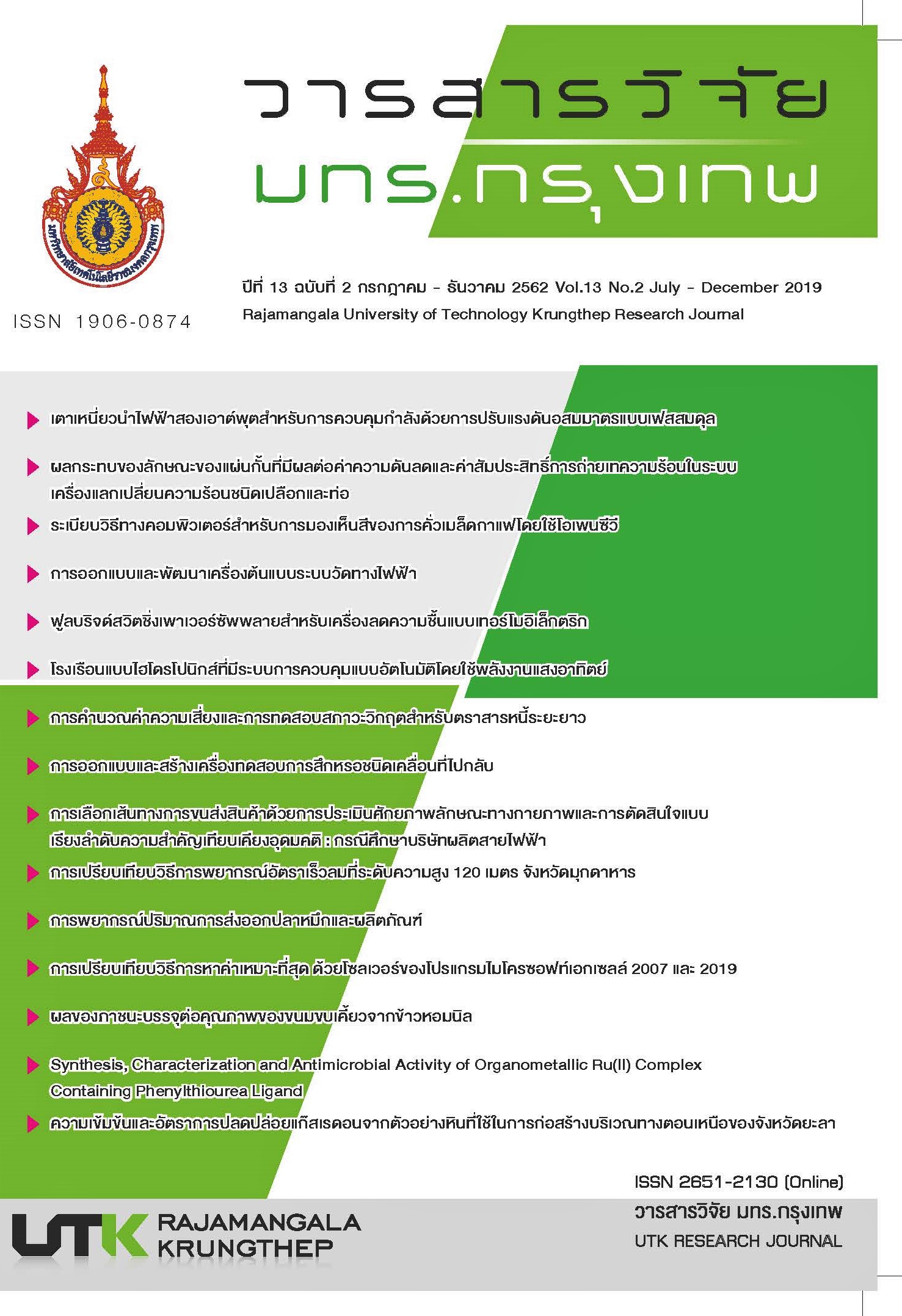การออกแบบและสร้างเครื่องทดสอบการสึกหรอชนิดเคลื่อนที่ไปกลับ
คำสำคัญ:
เครื่องทดสอบการสึกหรอ, อัตราการสึกหรอ, การทดสอบแบบเคลื่อนที่ไปกลับ, ASTM G133บทคัดย่อ
งานวิจัยนี้มีวัตถุประสงค์เพื่อออกแบบและผลิตเครื่องทดสอบการสึกหรอชนิดเคลื่อนที่ไปกลับ โดยเป็นระบบควบคุมด้วยมือ โดยเครื่องทดสอบที่ได้ต้องเกิดความสะดวกในการใช้งานและมีความคงทนสามารถที่จะใช้ทดสอบได้อย่างต่อเนื่องเป็นเวลานาน มีความเที่ยง และมีค่าความคลาดเคลื่อนจากค่าในทางทฤษฎี ไม่เกิน 10 % ผลปรากฏว่าเครื่องที่ได้มีขนาด 40 x 40 เซนติเมตร น้ำหนักประมาณ 30 กิโลกรัม ความเร็วรอบสูงสุดในการทดสอบ 600 รอบต่อนาที สามารถรับน้ำหนักกดได้สูงสุด 15 N จากการทดลองใช้เครื่องเพื่อทดสอบ โดยอ้างอิงมาตรฐานการทดสอบ ASTM G133 พบว่าเครื่องที่สร้างขึ้นมีความเที่ยงตรงที่ระดับความเชื่อมั่น 95 % และมีความคลาดเคลื่อนจากค่าในทางทฤษฎี ต่ำกว่า 10 %
เอกสารอ้างอิง
[2] Rabinowicz E. Investing in knowledge: Friction, Wear and Lubrication [อินเตอร์เน็ต]. [เข้าถึงเมื่อ 20 พ.ย. 2561]. จาก: www.machine design.com/
[3] Hatchett C. Experiments and observations on the various alloys, on the specific gravity, and on the comparative wear of gold. Phil Trans Roy Soc Lond. 1893; (93):43-194.
[4] Rennie G. Experiment on the friction and Abrasive wear of solids. Phil Trans Roy Soc Lond. 1829;(119).
[5] Zmitrowicz A. Wear patterns and laws of wear. Theor Appl Mech. 2006; (44):219-253.
[6] Archard JF. Contact and rubbing of flat surface. J Appl Phys. 1953; (24):981–88.
[7] Hirst W. Lancester JK. The influence of oxide and lubricant films on the friction and surface damage of metals. Phil Trans Roy Soc Lond Math Phys Sci. 1960; (259): 228–41.
[8] Eshaghi A. Ghasemi HM. Rassizadehghani J. Effect of heat treatment on microstructure and wear behavior of Al–Si alloys with various iron contents. Materials and Design.2011; 3(32):1520 – 25.
[9] Okonkwoa PC, Kelly G, Rolfe BF. et al. The effect of temperature on sliding wear of steel tool steel pairs. Wear. 2012; (282):22-30.
[10] Albers A, Savio D, Lorentz B. A model to investigate the influence of surface roughness on the tribological behavior of dry friction systems. GFT Fachtagung für Tribologie proceeding. 2010Sep 29. Göttingen. 2010.
[11] Kubiak KJ, Liskiewicz TW, Mathia TG. Surface morphology in engineering applications: Influence of roughness on sliding and wear in dry fretting. Tribol Int. 2011; (44) :1427-32.
[12] Nakamura Y, Muto J, Nagahama H. et al. Amorphization of quartz by friction: Implication to silica-gel lubrication of fault surfaces. Geophysical Research Letter. 2012; (39):21303-15.
[13] ASTM Committee on Standards. International Designation: G133. Standard Test Method for Linearly Reciprocating Ball-on-Flat Sliding Wear. Annual Book of Standards (03.02). West Conshohocken: Astm Intl; 2016.
[14] Rajan RK, Kumar H, Albert SK. et al. Sliding friction and wear characteristics of grade 410 martensitic stainless steel. Appl Mech Mater. 2014; (592-594):1346-51.
ดาวน์โหลด
เผยแพร่แล้ว
รูปแบบการอ้างอิง
ฉบับ
ประเภทบทความ
สัญญาอนุญาต
กองบรรณาธิการวารสารวิชาการ มหาวิทยาลัยเทคโนโลยีราชมงคลกรุงเทพ มีความยินดีที่จะรับบทความจากอาจารย์ นักวิจัย นักวิชาการทั้งภายในและภายนอกมหาวิทยาลัย ในสาขาวิชาวิทยาศาสตร์และเทคโนโลยี ได้แก่ สาขาวิชาวิทยาศาสตร์ วิศวกรรมศาสตร์ และสาขาอื่นๆ ที่เกี่ยวข้อง รวมถึงสาขาต่างๆ ที่มีการบูรณาการข้ามศาสตร์ที่เกี่ยวข้องวิทยาศาสตร์และเทคโนโลยี ที่เขียนเป็นภาษาไทยหรือภาษาอังกฤษ ซึ่งผลงานวิชาการที่ส่งมาขอตีพิมพ์ต้องไม่เคยเผยแพร่ในสิ่งพิมพ์อื่นใดมาก่อน และต้องไม่อยู่ในระหว่างการพิจารณาของวารสารอื่น
การละเมิดลิขสิทธิ์ถือเป็นความรับผิดชอบของผู้ส่งบทความโดยตรง บทความที่ได้รับการตีพิมพ์ต้องผ่านการพิจารณากลั่นกรองคุณภาพจากผู้ทรงคุณวุฒิและได้รับความเห็นชอบจากกองบรรณาธิการ
ข้อความที่ปรากฏอยู่ในแต่ละบทความที่ตีพิมพ์ในวารสารวิชาการเล่มนี้ เป็นความคิดเห็นส่วนตัวของผู้เขียนแต่ละท่าน ไม่เกี่ยวข้องกับมหาวิทยาลัยเทคโนโลยีราชมงคลกรุงเทพแต่อย่างใด ความรับผิดชอบด้านเนื้อหาและการตรวจร่างบทความแต่ละบทความเป็นของผู้เขียนแต่ละท่าน หากมีความผิดพลาดใดๆ ผู้เขียนแต่ละท่านจะต้องรับผิดชอบบทความของตนเองแต่ผู้เดียว
กองบรรณาธิการขอสงวนสิทธิ์มิให้นำเนื้อหา หรือข้อคิดเห็นใดๆ ของบทความในวารสารวิชาการ มหาวิทยาลัยเทคโนโลยีราชมงคลกรุงเทพ ไปเผยแพร่ก่อนได้รับอนุญาตจากกองบรรณาธิการ อย่างเป็นลายลักษณ์อักษร ผลงานที่ได้รับการตีพิมพ์ถือเป็นลิขสิทธิ์ของวารสาร






